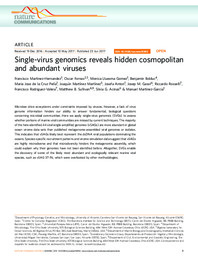Por favor, use este identificador para citar o enlazar este ítem:
https://hdl.handle.net/11000/4836Registro completo de metadatos
| Campo DC | Valor | Lengua/Idioma |
|---|---|---|
| dc.contributor.author | Martínez Hernández, Francisco | - |
| dc.contributor.author | Fornas, Óscar | - |
| dc.contributor.author | Lluesma Gómez, Mónica | - |
| dc.contributor.author | Bolduc, Benjamín | - |
| dc.contributor.author | De la Cruz Peña, María José | - |
| dc.contributor.author | Martínez Martínez, Joaquín | - |
| dc.contributor.author | Antón Ruiz, Josefa Antonia | - |
| dc.contributor.author | Gasol, Josep M. | - |
| dc.contributor.author | Rosselli, Riccardo | - |
| dc.contributor.author | Rodríguez Valera, Francisco | - |
| dc.contributor.author | Sullivan, Matthew B. | - |
| dc.contributor.author | Acinas, Silvia G. | - |
| dc.contributor.author | Martinez García, Manuel | - |
| dc.contributor.other | Departamentos de la UMH::Producción Vegetal y Microbiología | es |
| dc.date.accessioned | 2018-09-27T11:54:09Z | - |
| dc.date.available | 2018-09-27T11:54:09Z | - |
| dc.date.created | 2017-05-10 | - |
| dc.date.issued | 2018-09-27 | - |
| dc.identifier.uri | http://hdl.handle.net/11000/4836 | - |
| dc.description.abstract | Microbes drive ecosystems under constraints imposed by viruses. However, a lack of virus genome information hinders our ability to answer fundamental, biological questions concerning microbial communities. Here we apply single-virus genomics (SVGs) to assess whether portions of marine viral communities are missed by current techniques. The majority of the here-identified 44 viral single-amplified genomes (vSAGs) are more abundant in global ocean virome data sets than published metagenome-assembled viral genomes or isolates. This indicates that vSAGs likely best represent the dsDNA viral populations dominating the oceans. Species-specific recruitment patterns and virome simulation data suggest that vSAGs are highly microdiverse and that microdiversity hinders the metagenomic assembly, which could explain why their genomes have not been identified before. Altogether, SVGs enable the discovery of some of the likely most abundant and ecologically relevant marine viral species, such as vSAG 37-F6, which were overlooked by other methodologies | es |
| dc.description.sponsorship | This work has been supported by Spanish Ministry of Economy and Competitiveness (refs CGL2013-40564-R and SAF2013-49267-EXP) | - |
| dc.description.sponsorship | Generalitat Valenciana (ref. ACOM/ 2015/133 and ACIF/2015/332) | - |
| dc.description.sponsorship | The USA National Science Foundation (OCE#1536989) | - |
| dc.description.sponsorship | The USA Department of Energy (DE-SC0010580), | - |
| dc.description.sponsorship | Gordon and Betty Moore Foundation (grants 3305, 3790, and 5334). | - |
| dc.description.sponsorship | The Ohio Supercomputer supported genesharing network high performance compute time | - |
| dc.description.sponsorship | Work at BBMO was funded by Spanish project CT2015-70340-R. Work at CRG | - |
| dc.description.sponsorship | BIST and UPF was in part funded by the Spanish Ministry of Economy and Competitiveness, ‘Centro de Excelencia Severo Ochoa 2013-2017 | - |
| dc.description.sponsorship | The Spanish Ministry of Economy and Competitiveness, ‘Centro de Excelencia Maria de Maeztu 2016-2019 | - |
| dc.format | application/pdf | es |
| dc.format.extent | 13 | es |
| dc.language.iso | eng | es |
| dc.rights | info:eu-repo/semantics/openAccess | es |
| dc.subject.other | 579 - Microbiología | es |
| dc.title | Single-virus genomics reveals hidden cosmopolitan and abundant viruses | es |
| dc.type | info:eu-repo/semantics/article | es |
| dc.identifier.doi | 10.1038/ncomms15892 | - |
| dc.relation.publisherversion | https://doi.org/10.1038/ncomms15892 | - |

Ver/Abrir:
Single-virus genomics reveals hidden cosmopolitan and abundant viruses.pdf
3,36 MB
Adobe PDF
Compartir:
 La licencia se describe como: Atribución-NonComercial-NoDerivada 4.0 Internacional.
La licencia se describe como: Atribución-NonComercial-NoDerivada 4.0 Internacional.
.png)